The week at a glance
- Potential Western Sandpiper still in Devon
- Balearic Woodchat Shrike still in County Wexford
- Probable American Dunlin on Scilly
- Wood Duck still on Shetland
- Zitting Cisticolas still on Guernsey
It was a curiously quiet week this week, particularly following on from the busy seven days just gone, but "quiet" is, of course, rather a subjective term to use when there were new rarities everywhere and they continued to arrive throughout the week. Much of the country was bathed in warm sunshine by the time the weekend came along and overshoots continued to, er, overshoot! The knockout bird was missing though as the once-traditional Bank Holiday mega seemed to miss us once again.
It was hard to know what the cream of the crop was this week. In Devon, the much-discussed Western or Semipalmated Sandpiper was seen again at Dawlish Warren on 23rd–27th. Any resolution as to the bird's identity seems not much further forward: some say one, some say the other, though many still favour the much rarer option. There were no such identification problems for the first-summer male Balearic Woodchat Shrike that remained at Duncormick (Co. Wexford) to 23rd. On Scilly, a probable first-summer American Dunlin (the race hudsonia) was found on the beach at Porth Coose, St. Agnes on 26th. This could be the second record for Scilly, and Britain: one was seen a couple of autumns ago on St. Mary's. Shetland's long-staying drake Wood Duck was on Loch of Spiggie on 21st–27th — will it emulate the stay of the Hooded Merganser in Dorset? (That bird, by the way, was still present at Radipole Lake this week.) On Guernsey, the two Zitting Cisticolas were still at Port Soif to 24th. A Black-headed Bunting visited feeders in a garden in Jerbourg, Guernsey from 24th–27th at least.
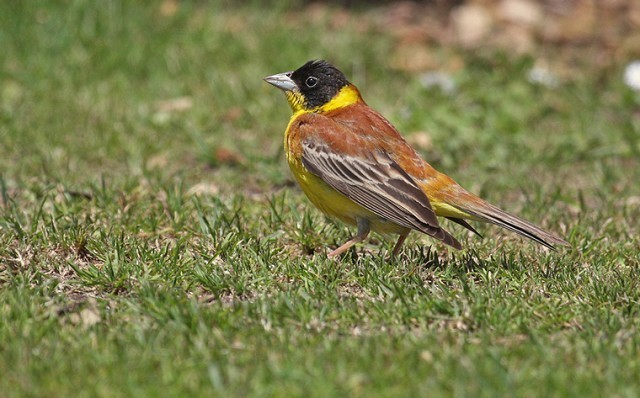
Black-headed Bunting, Jerbourg, Guernsey (Photo: Chris Bale)
After a couple of successive scores well in excess of 500, this week saw numbers of Pomarine Skuas fall away somewhat. Around 150 or so were noted with Cumbria, Dumfries & Galloway and the Outer Hebrides faring best with a handful of double figures each; 38 off Aird an Runair, North Uist was the highest count of the week, on 23rd. However, the big prize at the last-mentioned site was the movement of Long-tailed Skuas, also on 23rd, at least 295 adults counted (most passing by in a two-hour period in the middle of the day). A further 80 birds were noted throughout the rest of the week, including 30 from the Oban to Lochboisdale ferry on 23rd. Very few other seabirds were recorded, a few single Balearic Shearwaters the only other species of note.
Two Cattle Egrets were near Drift (Cornwall) on 22nd–23rd; one was at Horse Eye Level and Pevensey Levels (East Sussex) on 24th–25th with further singles at Timoleague (Co. Cork) on 24th and Summer Leys (Northamptonshire) on 27th. A Great White Egret lingered at Saltholme Pools (Cleveland) until 27th and new individuals were seen at Shear Water (Wiltshire) on 21st, Oare Marshes (Kent) on 23rd (with presumably the same bird seen on Sheppey on 27th) and Lough Beg (Co. Cork) on 24th. There was a very impressive showing of Spoonbills this week, with as many as 60 birds being seen, with seven at North Warren (Suffolk) on 27th the biggest flock noted. Not far behind were the six heading east over Sheringham (Norfolk) on 24th and, also in Norfolk, the five that flew over Holme on 23rd, along with further quintets at Inner Marsh Farm (Cheshire) on 25th–26th and Newport Wetlands (Gwent) on 26th. Elsewhere, four birds were seen at Holland Haven CP (Essex) on 21st, four flew over Dungeness (Kent) on 22nd and, still in Kent, four were at Elmley Marshes the same day (three had been seen there the previous day). Four Spoonbills were at Oare Marshes briefly on 24th. Also of note were the two Spoonbills that flew over Skomer (Pembrokeshire) on 23rd.

Spoonbill, Grove Ferry NNR, Kent (Photo: Steve Ashton)
A Common Crane was seen around sites in East and North Yorkshire between 21st and 23rd with one in Lincolnshire on 24th, while in Norfolk on 25th, three flew west over Kelling, Cley and Warham and were last seen over Foulsham. Also on 25th, a lone Crane was seen over Tyninghame Bay (Lothian). The largest group of the week though was the flock of five birds seen flying over Bawtry (South Yorkshire) on 27th. A White Stork flew over the River Avon (Worcestershire) on 23rd, with further singles on the same day appearing at Dibden Purlieu (Hampshire) and on a lawn at Alnwick (Northumberland). On 24th, single White Storks were at Shefford (Bedfordshire) and South Queensferry (Lothian). An adult Purple Heron was seen and photographed at a private site near Dereham (Norfolk) early in the week, with further individuals seen at Reculver and Grove Ferry (Kent) on 23rd and Camden Town (London) and Lakenheath Fen (Suffolk) on 24th. Once again, the most glamorous heron of the week was the first-summer Squacco Heron (relocating from Suffolk), found at Wicken Fen (Cambridgeshire) on 24th–27th (the second record for the county this decade). A singing male Spotted Crake was at Balemore, North Uist (Outer Hebrides) from 22nd and further singing males were in Tayside and Dorset.

Purple Heron, Reculver, Kent (Photo: Marc Heath)

Squacco Heron, Wicken Fen NT, Cambridgeshire (Photo: Steve Blain)
A Canada Goose sp. was seen at Loch of Strathbeg (Aberdeenshire) on 21st with a group of around 40 Pink-footed Geese, and another Canada Goose was seen on Whalsay (Shetland) on 24th. A drake Black Duck was at Colliford Lake (Cornwall) on 24th and seems likely to be the bird seen there on May 23rd 2007 (and present from time to time in 2000–2003). The drake Lesser Scaup was back on the Loch of Benston (Shetland) to 25th, moving to Loch of Houlland on 27th, a drake Ring-necked Duck was on North Loch Eynort (South Uist) on 25th–27th and the drake Ferruginous Duck was still at Chew Valley Lake (Somerset) to 27th. In Scotland, a first-summer American Wigeon was at Port Allen (Perth & Kinross) from 24th and a drake Surf Scoter was off Blackdog (Aberdeenshire) on 24th–25th.
Black Kite records were initially confined to East Anglia this week: one over Rendlesham Forest (Suffolk) on 21st with further singles reported in Norfolk at Breydon Water on 22nd and Flitcham on 24th (a Rough-legged Buzzard was at nearby Roydon Common on the same date). The eastern monopoly of Black Kites was broken by one on St. Agnes, Tresco and St. Martin's (Scilly), also on 24th, with perhaps the same bird making landfall on the Cornish mainland at Zennor and Clodgy Point the following day (as the influx of Red Kites continued). Also on 25th, a Black Kite flew over Great Bromley (Essex) and another was reported at Marshfield (Gloucestershire) on 26th. On the final day of the week, two Black Kites flew over Sandwich (Kent).
A first-summer male Red-footed Falcon was found at Hatfield Moors (South Yorkshire) on 24th by birders visiting the Buff-breasted Sandpiper there. Honey Buzzards were seen from Dorset to Wexford and up to Shetland, with regular breeding sites in Norfolk and North Yorkshire starting to draw birders as summering individuals settled down for another season. An adult male Snowy Owl was still on St. Kilda (Outer Hebrides) on 21st (having last been reported on April 30th) with another still on Inishkea Island (Co. Mayo) on the same date.

Honey Buzzard, undisclosed site, Hampshire (Photo: Martin Gillingham)
It was another interesting week for wader-watchers and the star of the show has to be the Terek Sandpiper found at Patrington Haven (East Yorkshire) on 23rd. This second for the county (the first was at Kilnsea in June 2002) spent just a couple of hours on site before flying east. Two Buff-breasted Sandpipers were new this week: the first arrived at Hatfield Moors on 23rd and was followed by another at Alkborough Flats (Lincolnshire) on 24th.

Terek Sandpiper, Patrington Haven, East Yorkshire (Photo: Martin Standley)

Buff-breasted Sandpiper, Alkborough Flats, Lincolnshire (Photo: Graham Catley)
After a typical early-to-mid-May peak, just four Temminck's Stints were on offer this week: single birds at Fen Drayton Lakes (Cambridgeshire) on 21st and Pagham Harbour (West Sussex) on 26th, with two at Branston GPs (Staffordshire) on the latter date. Only five Dotterel were reported: singles were in the Highlands, near Cromarty, on 21st and at Danby Beacon (North Yorkshire) on 26th with three at Donna Nook (Lincolnshire) on 25th. The Red-necked Phalarope was still at Bru, Lewis (Outer Hebrides) early in the week, at least five were seen at the traditional (wardened) breeding site on Fetlar (Shetland), and on 27th four were seen in Stinky Bay, Benbecula (Outer Hebrides). Mainland Red-necked Phalaropes appeared at Tarland (Aberdeenshire) on 25th and Belvide Reservoir (Staffordshire) on 27th.
The Black-winged Pratincole remained around Grove Ferry and Stodmarsh (Kent) until the morning of 25th before moving to Elmley Marshes, and the Collared Pratincole remained between Cley and Blakeney (Norfolk) until the early morning of 23rd before relocating, some 140 miles to the northwest, to Swillington Ings (West Yorkshire) later the same day. The bird remained in place across the Bank Holiday weekend and would surely have been well received by county listers: just three are on the West Yorkshire books, the last being over 20 years ago. On 26th, a Collared Pratincole was reported from Pugney's CP in the early part of the afternoon while the previous day had seen a probable Collared Pratincole appear in Oxfordshire: another hop?
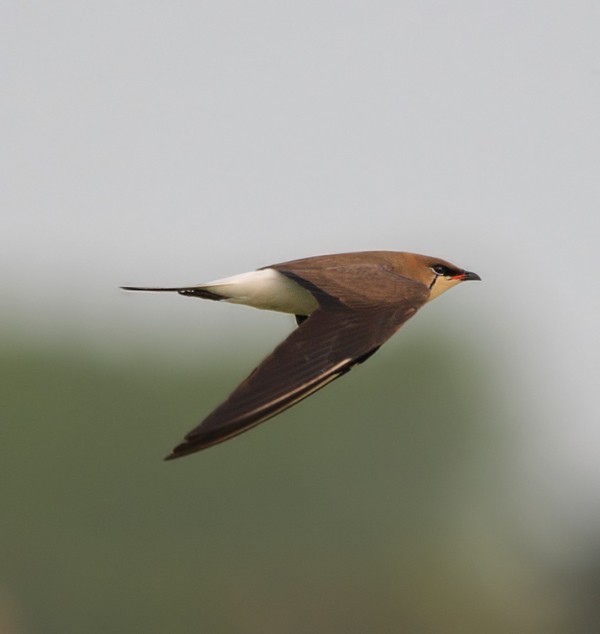
Black-winged Pratincole, Grove Ferry NNR, Kent (Photo: Steve Ashton)

Collared Pratincole, Cley Marshes NWT, Norfolk (Photo: Kris Gibb)
Birders taking in the Collared Pratincole at Swillington on 24th must have been delighted when three Whiskered Terns appeared on site — a neat species double act! Just like the Pratincole, this represents the fourth record for the county, although it is just under two years (rather than 20) since a Whiskered Tern graced West Yorkshire. In one of those peculiar birding quirks of fate, just like the Collared Pratincole the Whiskered Terns started off in Norfolk: three birds were at Snettisham on 23rd until mid-afternoon (though news only emerged the following day). However, the coincidence of the Pratincole and the Terns appearing at the same site is quite extraordinary. A lone Whiskered Tern remained at Swillington on 25th, when one moved to Fairburn Ings (West Yorkshire) and by early evening two had arrived at Wombwell Ings and Broomhill Flash (South Yorkshire). By the morning of 26th, the South Yorkshire duo had headed south, to Summer Leys (Northamptonshire) — the first record in the county since 1991.

Whiskered Tern, Summer Leys LNR, Northamptonshire (Photo: Douglas McFarlane)
In Devon, a Gull-billed Tern was seen at Topsham and Dawlish Warren on 23rd and a Caspian Tern flew over Freiston Shore (Lincolnshire) on 22nd. In County Wexford, the Forster's Tern was again at Tacumshin on 24th.
An adult Laughing Gull flew north over Skomer Island on 21st before arriving, four days later, at Marton Mere (Lancashire). Another adult was found on 25th at Testwood Lakes (Hampshire) on 25th, only the second record for the county following on from one in November 2005. The second-summer bird remained on south Mainland (Shetland) to 27th, while the island's adult Franklin's Gull was seen again on 24th–25th on Unst as its northward journey continues. A handful of Iceland Gulls and Glaucous Gulls were seen this week; the former only just reached double figures, mainly due to four second-year birds at Ballyheige Bay (Co. Kerry) on 24th.

Laughing Gull, Marton Mere, Lancashire (Photo: Michael A McGough)
The Pallid Swift was again at Crosby and Seaforth (Merseyside) on 21st–22nd and again on 26th–27th, while the only Wryneck of the week was seen on Ramsey Island (Pembrokeshire) on 24th. A Hoopoe was at Elmley Marshes on 25th with another in Stansted Forest (West Sussex) on 26th.
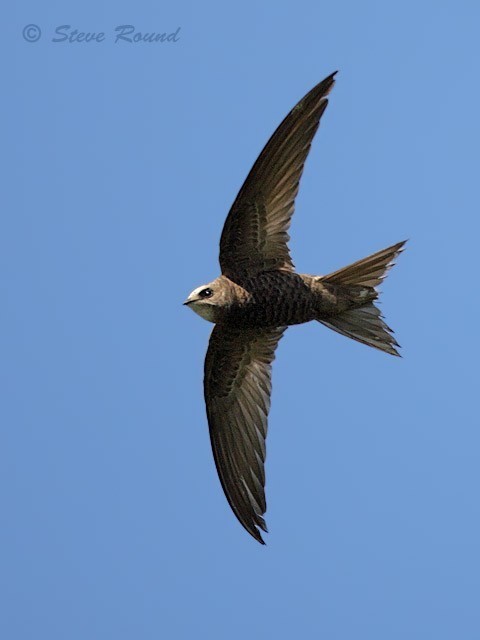
Pallid Swift, Seaforth LWT (Permit only), Lancashire (Photo: Steve Round)
A Bee-eater was seen on Fair Isle (Shetland) on 22nd and was followed by one at Land's End (Cornwall) on 23rd when one was seen at Brading Marshes (Isle of Wight) and three were reported over Cley Marshes (Norfolk). The 24th saw 15 birds arrive along the south coast: a group of three was at Broadstone (Dorset), a flock of five were at Bough Beech Reservoir (Kent) and seven flew over Old Town, St. Mary's (Scilly). On 25th, three Bee-eaters were at Rye Harbour (East Sussex) and the final bird of the week flew over Spurn (East Yorkshire) on 27th, settling later in the evening at Easington.

European Bee-eater, Easington, East Yorkshire (Photo: Martin Standley)
For the second week in a row, a Red-rumped Swallow flew past Spurn (East Yorkshire), this one on 21st, with further singles at Lizard Point (Cornwall) and Eastleigh and Bishopstoke (Hampshire), both on 23rd, and one or two on Tresco and St. Mary's (Scilly) on 24th.
After an impressive 65+ last week, the number of Bluethroats fell away sharply this week: just six birds were recorded, with four on Shetland (two for the mainland, two for Fair Isle) and singles on Orkney (on North Ronaldsay) and Northumberland (at Newbiggin-by-the-sea), both on 22nd.
Red-backed Shrikes were seen on Scilly, in Devon, Norfolk, Fife, Shetland, Gwynedd and Pembrokeshire this week (the final bird appearing on Ramsey Island on 24th). Four (or possibly five) Woodchat Shrikes were seen: two in Dorset (at Portland and Langton Matravers) one or two in Norfolk (at Horsey and Mundesley) and a male at Pugney's CP (West Yorkshire) on 24th which completed an impressive two-day spell for the inland county.

Woodchat Shrike, Pugney's CP, West Yorkshire (Photo: Marcus Conway)
Around a dozen migrant Golden Orioles were recorded this week from Scilly to Shetland, and the latter island group hosted a Waxwing out on the dramatic coastline of Esha Ness on 21st.

Waxwing, Esha Ness, Mainland, Shetland (Photo: Willie)
As with Bluethroat, the number of Icterine Warblers slumped to well under double figures this week. Just seven birds were noted, six of them on Shetland, including two on Fair Isle on 26th. The lone mainland bird was at Easington (East Yorkshire) on 21st. Four Melodious Warblers appeared: singles at Land's End (Cornwall) and Spurn (East Yorkshire) on 23rd were followed by a singing male at Beachy Head (East Sussex) and one at Croft Pascoe Pool (Cornwall) on 24th. A Subalpine Warbler was on Fair Isle on 21st and males were at Land's End and Scatness (Shetland) on 22nd, the latter bird remaining to 24th.

Icterine Warbler, Bardsey Island, Gwynedd (Photo: Steve Stansfield)

Subalpine Warbler, Scatness, Mainland, Shetland (Photo: Steve Minton)
The singing male Savi's Warbler at the Lee Valley CP (Essex) was present from 21st–26th. A singing male Great Reed Warbler was heard at East Patrington (East Yorkshire) on 27th, but failed to show itself later.

Savi's Warbler, Lee Valley CP, Essex (Photo: Richard Bayldon)
Serins were recorded over Gibraltar Point (Lincolnshire) on 23rd and at Portland (Dorset) on 24th. Two Common Rosefinches were on Fair Isle on 24th, with further singles on 25th being a ten-minute early-morning visitor to the dunes at Burnham Overy (Norfolk) and another on North Ronaldsay (Orkney). Birders on Ronaldsay also enjoyed the week's only Ortolan Bunting, present on 26th, and the same date saw a Rustic Bunting arrive on Fair Isle.

Ortolan Bunting, North Ronaldsay, Orkney (Photo: anon)
Photo of the Week

Arctic Tern, Lerwick, Mainland, Shetland (Photo:
Robbie Brookes)
As well as having incredible migration behaviour, Arctic Terns are also beautiful birds, their every detail exuding elegance. Photographically, their brilliant red bills provide a perfect accent colour against their otherwise monochrome plumage. In Robbie Brookes' close-up shot of a pair of Arctic Terns, this red highlight draws attention to the centre of the frame, where a food-pass is captured in pin-sharp detail. Freezing the action at the precise instant the fish is transferred from bill to bill, Robbie has created both a behavioural record and an aesthetic image.
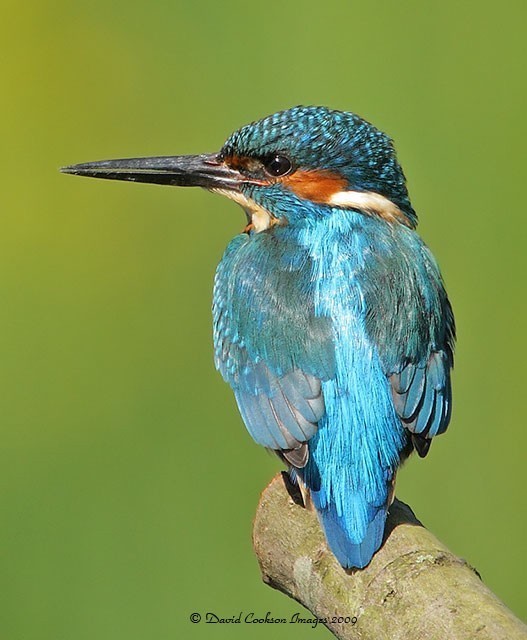
Common Kingfisher, Mere Sands Wood LWT, Lancashire (Photo:
David Cookson)

Common Treecreeper, Dunham Massey Park, Greater Manchester (Photo:
David Cookson)

Osprey, Aviemore, Highland (Photo:
Mark Hancox)
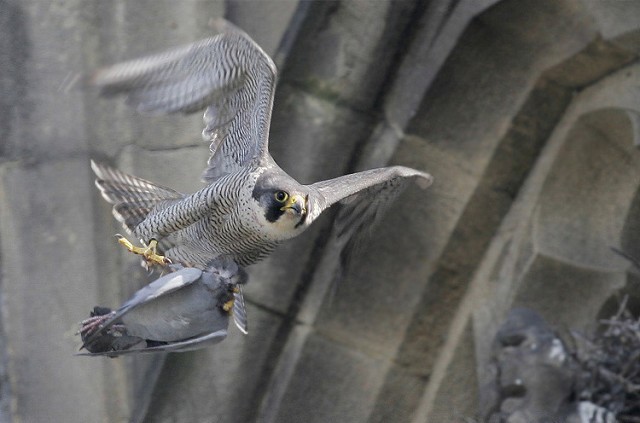
Peregrine Falcon, Manchester, Greater Manchester (Photo:
A.Dancy)

Guillemot, Stack Rocks, Pembrokeshire (Photo:
Richard Crossen)

White-tailed Eagle, undisclosed site, Highland (Photo:
Mike Thrower)

Pallid Swift, Seaforth LWT (Permit only), Lancashire (Photo:
Steve Round)

Buff-breasted Sandpiper, Alkborough Flats, Lincolnshire (Photo:
Graham Catley)

Yellow Wagtail, Alkborough Flats, Lincolnshire (Photo:
Graham Catley)

Common Redstart, Aymestrey, Herefordshire (Photo:
George Ewart)

Nightingale, Minsmere Heath, Suffolk (Photo:
David Whistlecraft)

Dotterel, Carn Ban Mor, Highland (Photo:
Dave Perrett)

Sanderling, North Wirral, Cheshire (Photo:
Richard Steel)

Black-necked Grebe, undisclosed site, Cheshire (Photo:
Kev Joynes)

Blue Tit, Lackford Lakes SWT, Suffolk (Photo:
Carl Wright)

